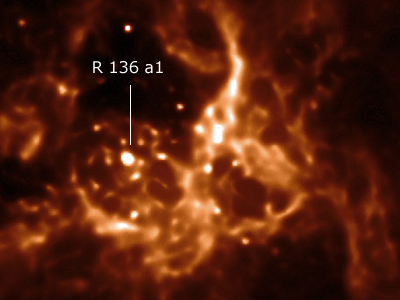 |
CHAMÄLEON + ONJALA OBSERVATORY DeepSky | SITEMAP HOME CHAMÄLEON |
|
 |
|||
| « back to overview Nebulae | Load higher resolution (1800 x 1200 Pixel) (3500 x 2300 Pixel) | Object description |

Load image with some NGC object names and the position of Supernova 1987 A (1800 x 1200 Pixel)
NGC 2070, also known as 30 Doradus or Tarantula Nebula, is the name of a very bright emission nebula located in the Large Magellanic Cloud in the constellation Swordfish (Dorado). It is the largest known star forming region in the local group and can be seen in small telescopes already despite its distance of about 170,000 light years.
The apparent diameter is about 30 x 20 arc monute (which corresponds roughly to the diameter of the full moon seen with the naked eye), which is about 1,000 light years (core region). If the tarantula nebulae in our Galaxy were in place of the Orion Nebula, it would cover a quarter of the sky and would even be visible in daylight. It owes its name to the arrangement of its brightest nebulae, which resemble the legs of a spider.
 |
In
total, 30 doradus contains gas from about 500 million solar masses. Embedded in
the core area of NGC 2070 is a very young open star cluster called R 136, and
these stars stimulate the entire nebula complex to glow. It contains some of
the youngest and most massive stars known. The compact star cluster
Hodge 301 contributes to the ionization of the nebula
complex. The star with the designation R 136 a1 is part of a whole cluster of young, massive and extremely hot giant stars and only about 1 million years old. With 256 solar masses and a size of 35 times the solar diameter it is the largest known single star. Two other giant stars with a total of 150 solar masses are also located in the core of R 136. The Tarantula Nebula was first mentioned in 1751 by the French astronomer Nicolas Louis de Lacaille. He catalogued the object as a normal star and gave it the catalog designation 30 Doradus. « R 136, CDK 17 at f = 2.350mm, EOS 40 DA, 6 x 120 Sek. |
| » The "superstar" R 136 a1 in the center of the
Tarantula Nebula. The picture shows an "age old" CCD image of us, taken in the
near infrared. It shows the core of 30 Doradus and the star R 136 a1. The
wavelength of the IR edge filter was about 870nm, the focal length almost
2.800mm (Celestron 11 in primary focus), no further image data are
available. You can find more pictures of the region from us here ... and a widefield image of the Large Magellanic Cloud here. top of page |
 |
 |
 |
 |
 |
 |
 |
 |
| Sun | Moon | Solar System | DeepSky | Widefield | Miscellaneous | Spec. Projects |